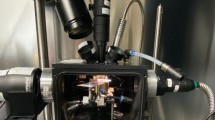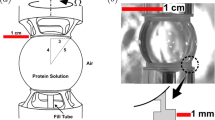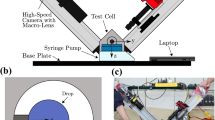Abstract
We present in here validation studies of a new method for application in microgravity environment which measures the viscosity of highly viscous undercooled liquids using drop coalescence. The method has the advantage of avoiding heterogeneous nucleation at container walls caused by crystallization of undercooled liquids during processing. Homogeneous nucleation can also be avoided due to the rapidity of the measurement using this method. The technique relies on measurements from experiments conducted in near zero gravity environment as well as highly accurate analytical formulation for the coalescence process. The viscosity of the liquid is determined by allowing the computed free surface shape relaxation time to be adjusted in response to the measured free surface velocity for two coalescing drops. Results are presented from two sets of validation experiments for the method which were conducted on board aircraft flying parabolic trajectories. In these tests the viscosity of a highly viscous liquid, namely glycerin, was determined at different temperatures using the drop coalescence method described in here. The experiments measured the free surface velocity of two glycerin drops coalescing under the action of surface tension alone in low gravity environment using high speed photography. The liquid viscosity was determined by adjusting the computed free surface velocity values to the measured experimental data. The results of these experiments were found to agree reasonably well with the known viscosity for the test liquid used.
Similar content being viewed by others
References
Turnbull, D.: Under What Gravity Can Glass be Formed? Contemp. Phys., vol. 10, p. 473 (1969).
Gutzov, I., Russel, C., Durschang, B.: Crystallization of glass Forming Melts Under Hydrostatic Pressure and Shear Stress. J. Material Sc., vol. 32, p. 5405 (1997).
Miani, F., Matteazzi, P.: Estimation of Viscosity in Undercooled Liquid Metal Alloys. J. Non-Crys. Solids, vol. 143, p. 140 (1992).
Ethridge, E. C.: Unpublished data (1995).
Trinh, E. H.: Fluid Dynamics and Solidification of Levitated Drops and Shells. Progress in Astronautics and Aeronautics, Koster J. N. and Sani, R. L. (Eds.), vol. 130, p. 515 (1990).
Lamb, H.: Hydrodynamics. Cambridge Univ. Press, (1932).
Prosperetti, A.: Normal-Mode Analysis for the Oscillation of Viscous Liquid Drop in an Immiscible Liquid. J. de Mec., vol. 19, p. 149 (1980).
Lundgren, T. S., Mansour, N. N.: Oscillation of Drops in Zero Gravity with Weak Viscous Effects. J. Fluid Mech., vol. 194, p. 479 (1988).
Basaran, O. A.: Nonlinear Oscillation of Viscous Liquid Drops. J. Fluid Mech., vol. 241, p. 169 (1992).
Happel, J., Brenner, H.: Low Reynolds Number Hydrodynamics. Prentice Hall (1965).
Ladyzhenskaya, O. A.: The Mathematical Theory of Viscous Incompressible Flow. Gordon & Breach, New York (1963).
Becker, A. A.: The Boundary Element Method in Engineering. McGraw-Hill (1992).
Vorst van de, G. A. L., Mattheij, R. M. M., Kuiken, H. K.: A Boundary Element Solution for Two-Dimensional Viscous Sintering. J. Comp. Phys., vol. 100, p. 50 (1992).
Vorst van de, G. A. L., Mattheij, R. M. M.: Simulation of Viscous Sintering. in B E Applications in Fluid mechanics, H. Power, Ed., Computational Mechanics Publications, Southampton and Boston, p. 215 (1995).
Antar, B. N., Nuotio-Antar, V. S.: Fundamentals of Low Gravity Fluid Dynamics and Heat Transfer. CRC Press, Boca Raton (1993).
Hopper, R. W.: Coalescence of Two Viscous Cylinders by Capillarity: Part I, Theory. J. Am. Ceram. Soc., vol. 76, p. 1947 (1993).
Hopper, R. W.: Coalescence of Two Viscous Cylinders by Capillarity: Part II, Shape Evolution. J. Am. Ceram. Soc., vol. 76, p. 2953 (1993).
CRC Handbook of Chem. and Phys., 68th edition, CRC Press (1987–1988).
Author information
Authors and Affiliations
Rights and permissions
About this article
Cite this article
Antar, B.N., Ethridge, E.C. & Maxwell, D. Viscosity measurement using drop coalescence in microgravity. Microgravity Sci. Technol 14, 9–19 (2003). https://doi.org/10.1007/BF02873332
Received:
Revised:
Accepted:
Issue Date:
DOI: https://doi.org/10.1007/BF02873332




